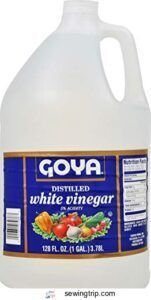This site is supported by our readers. We may earn a commission, at no cost to you, if you purchase through links.
 You can keep flannel from pilling by washing it on a gentle cycle with cold water and skipping fabric softeners that weaken fibers. Air-dry your sheets or use low heat in the dryer, since high temperatures cause the friction that creates those annoying fuzz balls.
You can keep flannel from pilling by washing it on a gentle cycle with cold water and skipping fabric softeners that weaken fibers. Air-dry your sheets or use low heat in the dryer, since high temperatures cause the friction that creates those annoying fuzz balls.
Choose high-quality flannel with long-staple cotton or bamboo fibers, which resist breakdown better than cheap alternatives. Don’t overload your washing machine – crowded sheets rub against each other and create more pills.
Store your flannel flat or loosely folded to prevent fiber stress. These simple changes can extend your flannel’s smooth, cozy feel for years instead of months.
Table Of Contents
- Key Takeaways
- What is Pilling and How Does It Affect Flannel?
- How to Prevent and Fix Pilling on Flannel Sheets
- Choosing The Best Flannel Sheets to Avoid Pilling
- Proper Washing and Drying Techniques for Flannel Sheets
- How to Remove Fuzz and Pills From Flannel Sheets
- Understanding The Effects of Drying Flannel Sheets
- Addressing Wrinkles in Flannel Sheets
- When to Consider Buying New Flannel Sheets
- Tips for a Perfect Night’s Sleep With Flannel Sheets
- Frequently Asked Questions (FAQs)
- Conclusion
Key Takeaways
- Wash gently with cold water – Use your machine’s gentle cycle and cold water to prevent fiber breakdown that causes pills, and skip fabric softeners that weaken flannel fibers.
- Choose quality flannel upfront – Buy flannel made with long-staple cotton or bamboo fibers since they’re more resistant to pilling than cheap, short-fiber alternatives.
- Air-dry or use low heat – High dryer temperatures create the friction that forms pills, so hang your sheets to dry or use your dryer’s lowest heat setting.
- Don’t overload your washer – Give your flannel room to move freely during washing since crowded sheets rub against each other and create more pilling.
What is Pilling and How Does It Affect Flannel?

You probably don’t think much about those tiny fabric balls on your flannel sheets until they turn your cozy bedding into a scratchy mess.
Pilling happens when loose fibers tangle together from friction during washing, sleeping, and normal wear, making your once-soft flannel feel rough and look worn out.
Common Materials Affected
Why does flannel develop those annoying fabric pills?
Cotton pilling occurs when short fibers break and tangle together during washing and use.
Bamboo durability makes it less prone to pilling than cotton, while microfiber benefits include pill resistance due to tightly woven synthetic fibers.
Wool concerns include natural pilling tendencies, and understanding these flannel pill causes helps you choose better materials for flannel pilling prevention.
Cotton

Cotton flannel sheets face a unique pilling challenge because of their fiber structure.
Short fibers break down faster, creating those pesky fabric balls that ruin your cozy nights
Short-staple cotton fibers break down faster than long-staple varieties, creating those annoying fabric balls you’ve probably noticed. The quality makes all the difference—combed cotton and organic cotton options resist pilling better than standard cotton blends.
Quality beats quantity—invest in long-staple cotton for sheets that stay smooth longer
Here’s what affects cotton flannel pilling:
- Cotton grades: Higher-grade cotton has longer, stronger fibers
- Staple length: Long-staple cotton creates smoother, more durable sheets
- Cotton blends: Pure cotton often pills less than synthetic blends
Understanding these factors helps you choose better flannel fabric care strategies for preventing fabric pills.
Bamboo
Unlike cotton’s short fibers, bamboo flannel sheets resist pilling better thanks to their smooth, long fiber structure.
You’ll find bamboo’s natural durability helps prevent fabric pills from forming as easily. However, bamboo blends can still pill, so proper care matters.
| Bamboo Feature | Pilling Resistance | Care Requirement |
|---|---|---|
| Pure bamboo fibers | High resistance | Gentle washing |
| Bamboo blends | Moderate resistance | Extra caution needed |
| Bamboo sourcing quality | Varies by manufacturer | Research brands |
| Bamboo softness | Maintains with care | Avoid fabric softener |
| Bamboo alternatives | Consider microfiber | Compare options |
Microfiber
Everything about microfiber flannel sheets screams synthetic blends and weave density.
These tightly woven synthetic materials resist flannel pilling better than cotton alternatives.
Here’s why microfiber works:
- Synthetic fibers create stronger bonds that won’t break easily
- Tight weave density prevents loose threads from forming pills
- Care instructions remain simple – gentle cycles still apply
Despite excellent pill resistance, you’ll still need proper fabric shaver maintenance.
Flannel
While microfiber resists pilling, traditional flannel faces different challenges.
Flannel origins trace back to warm wool fabrics, but today’s cotton versions create pills through friction. Weave variations and GSM ratings determine flannel pill causes – lighter weights pill more.
Understanding these flannel care instructions helps stop flannel pilling effectively.
Here’s what causes flannel sheets to develop those pesky fuzz balls:
- Washing machine agitation – The drum’s spinning action loosens short cotton fibers that tangle together
- Heat exposure – Hot water and high dryer temperatures break down fiber structure, creating weak spots
- Fabric softener damage – These products coat fibers, making them more likely to break and form pills
- Low GSM ratings – Lightweight flannel under 155 GSM lacks density to resist pilling from seasonal use
Removing flannel pills requires gentle flannel washing tips and proper ethical sourcing choices upfront.
Low-Quality Fabric
Your flannel’s fiber length and weave density directly impact pilling resistance.
Short-staple fibers create more loose fibers that tangle together, while long-staple cotton offers superior durability.
When manufacturers cut corners with cheap dyes and material blends, you’re left with flannel that pills faster than you can say "cozy night’s sleep."
Flannel quality factors like weave density matter more than thread count.
Tightly woven fabrics resist pilling better because there’s less room for fibers to work loose and form those annoying little balls.
Low-grade flannel often combines short fibers with loose weaving, creating the perfect storm for pilling.
Understanding why does flannel pill helps you spot quality issues early.
Flannel pill causes include poor fiber selection and manufacturing shortcuts that prioritize cost over durability.
Investing in pilling resistant flannel with superior fabric quality saves money long-term and keeps your sheets feeling smooth for years.
How to Prevent and Fix Pilling on Flannel Sheets
Nobody wants their cozy flannel sheets turning into fuzzy, uncomfortable messes after just a few washes.
The good news is that you can fix existing pills and prevent new ones from forming with the right approach.
How to Fix Pilling
Pilling problems require immediate action to restore your flannel’s smooth texture.
You can tackle these pesky fabric pills with several effective methods:
- Razor technique: Gently glide a clean razor across the fabric surface to shave away stubborn pills
- Fuzz remover: Use a battery-operated fabric shaver for efficient pill removal without damaging fibers
- Scissor trimming: Carefully cut individual pills with sharp scissors, keeping fabric taut for precision
Use a Razor and Lint Roller
When pills appear on your flannel sheets, grab a disposable razor for quick pilling removal.
This razor technique works best with gentle, one-direction strokes at a slight angle.
Next, roll a sticky lint roller across the surface to capture loose fibers and prevent future fabric damage risk.
Some retailers offer products targeting this issue.
- Razor approach: Use light pressure and move systematically across pilled areas to avoid fabric tears
- Lint roller types: Choose adhesive rollers over reusable ones for better fuzz removal effectiveness
Cut Off The Pills With Scissors
When you spot larger fabric pills, grab a pair of sharp fabric scissors for precise removal.
Hold the flannel taut with one hand while carefully snipping each pill at its base, maintaining proper fabric tension to avoid accidental cuts.
Choose small, pointed scissors types for better cutting angles and control. These fabric scissors are available online.
Work slowly around pill size variations, taking safety precautions to prevent fabric damage during this DIY fuzz removal method.
Use a Battery-Operated Fuzz Remover
When scissors aren’t quite cutting it, a battery-operated fabric shaver becomes your secret weapon against stubborn pilling.
These handy devices work like tiny lawn mowers, using rotating blades to efficiently trim away fabric pills without damaging the underlying flannel fibers. As with cashmere, friction causes pilling, so gentle removal is key.
- Choose models with adjustable height settings to prevent fabric damage
- Clean the collection chamber regularly to maintain battery life and performance
- Test on a small, hidden area first to confirm compatibility with your flannel
- Store properly between uses to extend the pill remover’s effectiveness
Choosing The Best Flannel Sheets to Avoid Pilling
When shopping for new flannel sheets, you’ll want to focus on materials and construction quality that naturally resist pilling.
High-quality options like bamboo, percale, and linen sheets offer smoother fibers and tighter weaves that create fewer loose threads to tangle into those annoying little balls.
Best Sheets to Avoid Pilling
When shopping for flannel sheets, fiber quality and weave matters most for pilling prevention.
Egyptian cotton and Supima cotton sheets with extra-long staple fibers resist pilling through 250+ wash cycles.
Percale durability beats standard cotton blends, while bamboo softness comes with natural pill resistance.
Linen strength offers exceptional longevity with minimal surface wear over time.
For ideal comfort, consider sheets known for temperature regulation.
Percale Sheets
By choosing percale sheets with their tight one-over-one weave construction, you’ll substantially reduce pilling compared to looser flannel alternatives.
This percale weave creates a smooth surface that resists fabric breakdown and pill formation during regular use.
- Thread Count: Look for 200-400 thread count percale for ideal durability and pilling resistance
- Cotton Quality: Choose long-staple Egyptian or Supima cotton percale over short-staple blends
- Breathability Factor: Percale’s crisp texture maintains airflow while preventing lint accumulation
- Durability Tests: Quality percale withstands 100+ wash cycles with minimal surface pill formation
Linen Sheets
While percale offers crisp comfort, linen sheets provide an entirely different approach to pilling prevention.
You’ll discover linen’s natural durability comes from flax plant fibers that resist breakdown over time.
Linen Benefits include:
- Superior breathability – keeps you cool through hot nights
- Natural antimicrobial properties – fights bacteria and odors
- Exceptional longevity – lasts over 10 years with proper fabric care
- Moisture-wicking ability – absorbs sweat without feeling damp
- Softens beautifully – improves with each wash cycle
For hot sleepers, linen’s moisture-wicking abilities are a great choice.
Bamboo Sheets
Bamboo sheets offer superior pilling resistance compared to cotton flannel.
Their smooth fiber structure creates fewer friction points that cause pills to form. Quality bamboo weave maintains softness while resisting wear from washing techniques and daily use.
| Bamboo Benefits | Why It Matters |
|---|---|
| 40% less pilling | Keeps sheets looking new longer |
| 100+ wash cycles | Saves money on replacements |
| Natural eco-friendliness | Good for you and the planet |
Proper Washing and Drying Techniques for Flannel Sheets
How you wash and dry your flannel sheets makes all the difference in preventing those annoying fabric pills from forming.
The right techniques from your very first wash will keep your sheets soft and smooth for years to come.
The Initial Wash
Before your flannel sheets’ debut on your bed, give them an initial wash with white vinegar instead of detergent.
This vinegar benefits approach helps with setting fibers and prevents color bleeding while preparing the fabric for long-term use.
Skip fabric softener during this vital first wash, as it can actually encourage pilling later.
This simple prevention strategy sets the foundation for effective washing techniques moving forward.
Machine Cycle
Once you’ve prepped your sheets with that initial wash, the washing machine cycle becomes your flannel’s best friend.
Your washing machine’s gentle cycle reduces agitation levels that cause pilling by minimizing harsh movements.
Here’s your game plan:
- Use the gentle cycle – This cycle speed protects fibers from excessive friction
- Keep load size small – Overcrowded machines increase fabric rubbing and pill formation.
The gentle cycle’s reduced wash settings prevent your flannel from getting beat up during cleaning, keeping those cozy fibers intact.
Water Temperature
Temperature matters more than you might think when washing flannel.
Hot water opens fiber structure, making pilling worse by weakening cotton strands.
Cold water preserves fibers but limits detergent activation for thorough cleaning.
Warm water hits the sweet spot—it activates your detergent effectively while protecting delicate flannel fibers from damage that leads to those annoying pills.
Softeners and Additives
Skip fabric softener entirely—it creates residue buildup that weakens fibers and accelerates pilling.
Instead, add half a cup of white vinegar to your rinse cycle as a natural softener alternative. Vinegar removes detergent residue without fiber degradation.
For eco-friendly options, try wool dryer balls for mechanical softening without harmful laundry additives.
Preventing Pilling Over Time
Over time, smart washing habits and proper drying methods protect your flannel’s fiber quality and weave density.
Consistent fabric maintenance prevents pilling from becoming a recurring nightmare:
- Cool water washing preserves fabric integrity and prevents fiber damage
- Skip fabric softeners that weaken fibers and accelerate pill formation
- Air dry when possible to maintain weave density and extend lifespan
These storage practices keep your sheets pill-free longer.
Spot Clean With Care
When stains strike your flannel sheets, smart stain removal makes all the difference.
Gentle blotting prevents damage while harsh scrubbing creates more pilling problems.
Here’s your stain-fighting game plan:
- Pre-treat stains immediately – Fresh spills come out easier than set-in disasters
- Choose gentle detergent – Harsh chemicals weaken fibers and accelerate pilling
- Blot, don’t scrub – Aggressive rubbing damages fabric structure permanently
- Use fabric maintenance tools – Keep your lint roller and fabric shaver handy
How to Remove Fuzz and Pills From Flannel Sheets
Even the best flannel sheets will develop fuzz and pills over time, but you don’t have to live with them forever.
With the right tools and techniques, you can restore your sheets to their original softness and extend their lifespan.
How to Remove Fuzz
Light surface fuzz can make your flannel sheets look worn before their time. Fortunately, removing this unwelcome guest doesn’t require special skills or expensive tools.
Start with a lint roller for quick daily maintenance. Roll it gently across the fabric surface to catch loose fibers before they form stubborn clumps. For deeper fuzz removal, grab a fabric shaver – it’s like giving your sheets a professional haircut. To find the right one, you might want to compare lint roller options.
Here are your go-to DIY solutions for tackling fuzz:
- Razor technique: Use a clean disposable razor on a flat surface, shaving in one direction
- Tennis ball method: Rub a clean tennis ball over the fabric to lift surface lint
- Pumice stone approach: Gently massage circular motions to release trapped fibers
Regular lint removal prevents minor fuzz from developing into full pilling. Think of it as pill prevention – catching the problem early saves you headaches later.
How to Remove Pills That Have Already Formed
Several effective methods can tackle stubborn pills that have already formed on your flannel sheets. Each technique offers different advantages depending on the pill size and fabric condition.
| Method | Best For | Technique |
|---|---|---|
| Razor blade use | Large, stubborn pills | Gentle shaving motions on flat surface |
| Fabric shaver tips | Multiple small pills | Battery-powered device with circular motion |
| Lint roller types | Surface fuzz and light pills | Rolling action removes loose fibers |
| Scissor pill removal | Individual large pills | Careful cutting without damaging fabric |
| Pumice stone use | Textured pill clusters | Light rubbing removes embedded lint |
A fabric comb works wonders for gentle pill removal, while a dedicated pill remover offers professional results. Work slowly and keep fabric taut to avoid creating holes during the pilling removal process. This method requires patience and careful handling to prevent damage, ensuring the flannel sheets remain intact and look like new after the removal of stubborn pills, especially when using tools like razor blades or scissors.
Understanding The Effects of Drying Flannel Sheets
Proper drying techniques are essential for preventing pilling on your flannel sheets, as excessive heat and aggressive tumbling can damage the delicate fibers.
While air drying is always best, understanding how to use your dryer safely can help maintain your sheets’ softness and longevity when you’re in a pinch, and following proper techniques is crucial.
Can You Put Flannel Sheets in The Dryer?
You can put flannel sheets in the dryer, but it’s risky business. Dryer heat breaks down fibers and increases pilling risk. High temperatures cause shrinkage concerns that’ll leave your sheets too small for your mattress.
Dryer heat damages flannel fibers faster than you think—air drying saves your sheets from pilling doom
Air drying remains the gold standard for preserving flannel’s softness and preventing damage. To further enhance softness, consider adding fabric softener during the drying cycle.
- Use lowest heat setting – Select "air dry" or "delicate" to minimize fiber damage
- Add dryer balls – Wool dryer balls reduce static and help sheets dry evenly
- Remove while slightly damp – Prevents over-drying and reduces wrinkle formation
- Check frequently – Stop the cycle early to avoid excessive heat exposure
- Consider air drying instead – Hang sheets outdoors or use indoor drying racks
But, if You Really Need to Dry Your Flannel Sheets
While air drying remains the safest choice, life sometimes demands compromise.
If you absolutely must use your dryer, these precautions will protect your flannel from pilling damage:
- Low Heat Drying: Select the coolest tumble dry setting to prevent fiber breakdown and over-drying effects
- Dryer Ball Benefits: Add clean tennis balls or wool dryer balls to reduce drying time and minimize fabric friction
- Tumble Dry Setting: Use gentle cycles with shorter drying time reduction intervals to check progress frequently
These drying methods help maintain your flannel’s integrity while providing the convenience you need when air drying isn’t practical.
Does Flannel Shrink in The Dryer?
Yes, flannel shrinks in the dryer—cotton flannel typically shrinks 2-5% after the first heated cycle.
Pre-shrunk flannel resists this dimensional loss better than untreated varieties.
High dryer heat levels cause fiber contraction, making sheets lose up to 3 inches in length.
Choose low-heat drying methods for shrinkage prevention tips while maintaining proper laundry care.
Addressing Wrinkles in Flannel Sheets
Smoothing wrinkles from flannel sheets keeps your bedding looking fresh and inviting. While flannel’s brushed texture naturally resists some wrinkles, proper care prevents deep creases that make your bed look messy.
Here are four effective methods to tackle flannel sheet wrinkles:
- Remove sheets promptly – Pull flannel sheets from the washer immediately to prevent set-in wrinkles from forming during extended dampness.
- Use gentle heat – When ironing flannel, set your iron to low heat and work while sheets remain slightly damp for easier wrinkle removal.
- Try wrinkle sprays – Light misting with commercial wrinkle-release products can relax fibers without harsh drying techniques.
- Implement storage solutions – Fold sheets loosely or store them flat to prevent permanent creases between uses.
Skip fabric softeners during washing, as they can actually increase wrinkling while contributing to pilling issues over time. To further maintain the quality, consider using a gentle machine cycle when washing.
When to Consider Buying New Flannel Sheets
Even the best flannel sheets won’t last forever, and knowing when to replace them can save you from endless pilling battles.
You’ll want to start shopping for new sheets when your current ones develop excessive pilling that won’t come off, feel rough despite proper care, or show signs of thinning fabric.
When Should I Look for New Sheets?
Even the best flannel sheets won’t last forever, and knowing when to replace them can save you from restless nights.
Watch for these telltale signs that your bedding needs an upgrade:
- Fabric thinning and wear and tear – holes, frayed edges, or patches where the material feels paper-thin
- Severe pilling that won’t budge – when your fabric shaver can’t restore smoothness and comfort decline affects sleep quality
- Lost warmth and softness – bedding durability has reached its limit when flannel sheets feel rough or provide less insulation than when new
What Should I Look for When Buying New Sheets?
Shopping for new flannel sheets becomes less overwhelming when you know what separates quality from mediocre options.
Material quality makes the biggest difference in preventing future pilling headaches.
Look for these key features when selecting pilling resistant flannel:
- 100% long-staple cotton or premium materials like Egyptian or Pima cotton for superior fabric durability
- GSM rating of 155 or higher – flannel quality factors depend on weight, not thread count
- Twill or percale weave type that creates natural resistance to fiber breakdown
- Brand reputation with verified reviews mentioning long-term pill prevention
High-quality materials cost more upfront but save money over time.
Check care labels for gentle washing instructions – manufacturers confident in their fabric durability provide clear guidance.
Avoid blends with synthetic fibers that accelerate pilling.
Tips for a Perfect Night’s Sleep With Flannel Sheets
Beyond choosing quality flannel sheets, creating the perfect sleep environment guarantees maximum comfort and longevity.
Proper bedtime routine starts with maintaining ideal temperature around 65-68°F, which complements flannel’s natural warmth without overheating.
- Sleep Environment Setup: Position flannel sheets away from direct sunlight to prevent fiber breakdown and maintain sheet softness longer.
Your pillow choice affects how flannel sheets feel against your skin. Soft, breathable pillows complement flannel’s cozy texture.
Regular bedding care prevents pilling through gentle laundry tips: wash weekly using cool water and mild detergent. This pill prevention approach keeps your sleep sanctuary comfortable year-round.
Frequently Asked Questions (FAQs)
How do you prevent flannel sheets from Pilling?
Like untangling a fishing line that’s gotten worse with every cast, flannel pilling starts small but compounds quickly.
Choose high-quality, long-staple cotton flannel, wash inside-out on gentle cycle with cold water, skip fabric softeners, and air-dry when possible.
How to prevent flannel from Pilling?
Choose high-quality, long-staple cotton flannel with higher GSM. Wash inside-out on gentle cycle with cool water. Skip fabric softeners. Air-dry or use low heat. Remove pills with fabric shaver regularly.
Why are my flannel sheets Pilling?
Your flannel sheets are pilling because friction from washing, sleeping, and movement creates tiny fiber tangles. Heat, fabric softener, and low-quality materials accelerate this natural wear process.
Do flannel sheets pill?
Yes, flannel sheets do pill. Cotton flannel is especially prone to developing those annoying little fiber balls because of its natural structure.
Friction from washing, sleeping, and general wear creates the perfect storm for pilling to occur.
How do you care for flannel?
Treating flannel like a delicate friend means washing gently with cool water, skipping fabric softeners, air-drying when possible, and using lint rollers regularly to maintain softness.
Does microfiber cause flannel Pilling?
Microfiber doesn’t cause flannel to pill – it’s actually pill-resistant due to its tightly woven synthetic fibers.
However, washing microfiber items with your flannel sheets can increase friction and accelerate pilling on the flannel itself, which is related to the fact that microfiber is tightly woven synthetic fibers.
Can Pilling Be Completely Prevented on Flannel Sheets?
Complete prevention isn’t possible since pilling happens naturally with use and washing.
However, you can dramatically minimize it by choosing high-quality flannel, washing gently in cold water, and avoiding fabric softeners.
Can Pilling Be Fixed Once It Occurs on Flannel Sheets?
Pilling isn’t a death sentence for your beloved flannel sheets. You can remove those annoying fiber balls using fabric shavers, lint rollers, or carefully wielding scissors to restore softness.
Does the Thread Count of Flannel Sheets Affect Pilling?
Flannel sheets aren’t measured by thread count but by weight (gsm). Higher-quality, heavier flannel with tightly woven fibers resists pilling better than lightweight options.
How to keep flannel shirts from pilling?
An ounce of prevention is worth a pound of cure" – wash your flannel shirts inside-out on gentle cycles using cool water, skip fabric softeners, and air-dry to preserve fibers and prevent pilling.
Conclusion
Like a well-oiled machine, proper flannel care keeps your sheets smooth and cozy for years. Now you know how to keep flannel from pilling through gentle washing, cold water, and air-drying techniques.
Choose high-quality fabrics with long-staple fibers, avoid fabric softeners, and don’t overcrowd your washing machine. Store your flannel flat to prevent fiber stress. With these expert tips, you’ll enjoy pill-free flannel that maintains its soft comfort season after season.
- https://www.mattressclarity.com/bedding/sheets/how-to-get-rid-of-pilling/
- https://www.mondaymerch.com/resources/fabrics-and-materials/flannel
- https://heritageparklaundry.com/blogs/the-laundry-lowdown/how-to-wash-flannel-sheets
- https://buffalojackson.com/blogs/insight/how-to-wash-flannel
- https://www.castlery.com/us/blog/prevent-pilling-sheets



















